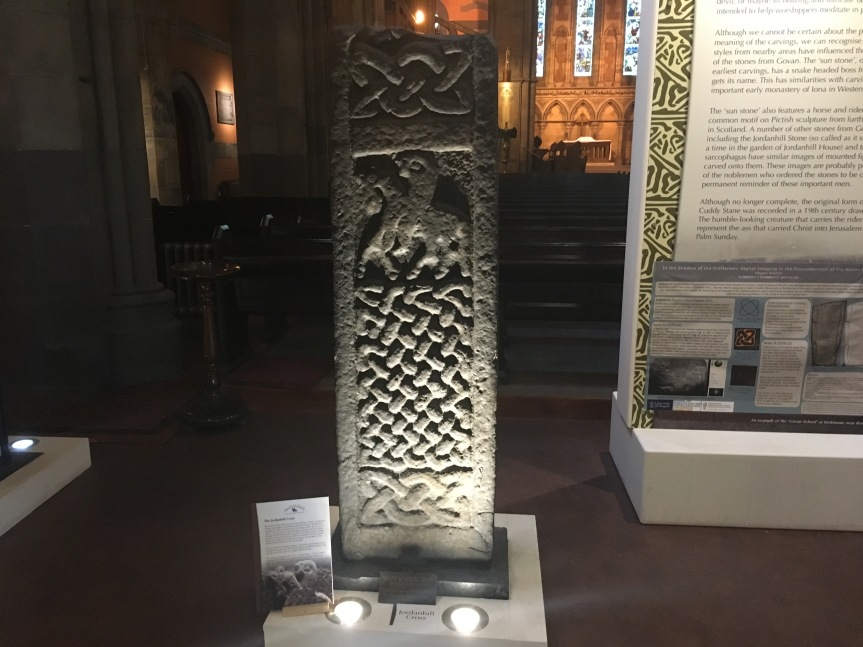By Gillian McPherson
When most people think of Govan’s history, they think of its shipbuilding tradition and the heyday of the Clydeside yards. The period when Scotland was the shipbuilder to the world and this area on the south bank of the river Clyde stood proudly at its centre. What most people certainly don’t tend to think of when they think of Govan is medieval kingdoms and Vikings.
But they really should. For as incongruous as the two may seem, dig a little deeper and look a little closer, and surprisingly you’ll find evidence of another equally fascinating, but somewhat forgotten era in Govan’s past. A time long before iron and steel made it famous. A time when Govan was the beating heart of a very different society.

Indeed, it might be difficult to reconcile with its more modern industrial connotations, but evidence suggests Govan was in fact once the religious, administrative and political capital of the Kingdom of Strathclyde, the lost kingdom of the Northern Britons.
It emerged as this powerful centre after the Vikings lay siege to the Britons at Dumbarton Rock for four months in AD 870. The Britons were eventually left with no choice but to surrender and Dumbarton, the capital of the Kingdom of Alt Clut, was destroyed by the Vikings. This did, however, not spell the end of the kingdom itself. Instead power moved up the Clyde and Govan emerged as the centre of what then became known as the Kingdom of Strathclyde.

The best evidence of this other important time in Govan’s history can be found just a short walk from the site of Govan’s famous Fairfield Yard, now part of BAE Systems. Here, wrapped in a semi-circular graveyard lies Govan Old Parish Church. The site has been a an significant place of Christian worship since the 6th century and at the time of the Kingdom of Strathclyde, was its important ecclesiastical centre. It is a place I have passed by countless times and until recently, remained like many other Glaswegians, utterly oblivious to its significance.
Inside, however, in the shadow of many ornate stain glass windows from the Victorian period, lies a unique collection of 31 stone monuments from a much earlier time in Govan’s past – The Govan Stones. A group of sculptures so remarkable that they were once described by the curator of the British Museum as “one of the best collections of early medieval sculpture anywhere on the British isles”.

The stone monuments were carved in the 9th and 11th centuries to commemorate the power of those who ruled the Kingdom of Strathclyde. Originally in the graveyard at the site of Govan Old Parish Church, many of these stones are believed to be evidence of an extremely high status, probably royal, cemetery at Govan. Despite this though it was only in the mid-19th century, however, that their historical importance began to be realised, but it took even longer for them to be brought inside for their protection.
Today the collection inside the church includes recumbent cross-slabs and free-standing crosses and cross shafts, as well as five, half-tonne curved hogback stones, the largest collection of its kind in the UK. The impressive hogbacks are similar to the shape of a Viking house and are characteristic of areas of Viking settlement in Yorkshire, Cumbria and Southern Scotland. The remainder of the stones do not show norse influence, but instead, Glasgow University professor Stephen Driscoll writes, exhibit features of British sculpture that extends to Wales.
The collection’s outstanding piece, however, is the Govan Sarcophagus with its intricate interlace carvings, hunting motifs and a mounted warrior. It is made from solid stone, which dates from pre-Norman Northern Britain and was found buried and empty in the churchyard in 1855 by gravediggers, who stumbled upon it between the root systems of two trees. Significantly, it is believed to have once held the relics of St Constantine.

However, despite the obvious importance and historical value of the Govan Stones, they are still not as well known as it should be. Indeed, many of those living in Glasgow are still not aware of their existence. Thankfully, however, they are now finally starting to get the recognition and awareness they deserve.
Indeed, this summer the collection was voted Scotland’s number one hidden gem. The Facebook poll run by Dig it! 2017, as part of the year of History, Heritage and Archeology, sought to shine a light on Scotland’s lesser known treasures and attracted over 12,000 votes before the Govan Stones were named the number one winner – Scotland’s top hidden gem – earlier this month.
“We were really excited about being nominated to be one of Scotland’s contenders to be one of the six hidden gems,” said Frazer Capie, the Govan Stone’s project coordinator. “The whole idea of it was to try and highlight little known sights or sights that have started to get their name out there, but don’t really get enough visitors and Govan hides this really amazing collection of early medieval sculpture.
“It’s one of the largest in the UK and it’s undoubtedly the least well known because its not been in a government run museum space. So really it was an opportunity to get our name out there and to get more Glasgow people visiting us and people from further afield as well.”

And it certainly seems to be working. Following the publicity from winning the competition visitor numbers have shot up in the past few weeks. Perhaps encouraged by the publicity and the story’s coverage online and on social media, when I arrived at 3pm, dozens of visitors from as far afield as Abu Dhabi had already been through the door since the church’s opening at 1pm. Fortunately it seems, people are finally starting to uncover Glasgow’s hidden gem.
Watch below to find out more about Govan’s remarkable collection of hogback stones…
Opening times
The Church is open daily to the public from 1pm to 4pm from April 1 to October 31. Admission is free, although donations are welcomed.
How to get there
The Govan Stones can be easily reached from Govan Subway station, which is a five minute walk away. Alternatively, if you are coming from the North side of the city, it is also possible to take the Govan Ferry, which runs from the Riverside Museum and Tall Ship, to a dock close to Govan Old Parish Church. This a free service, which relies on fundraising and donations and shuttles back and forth continuously across the Clyde throughout the summer months.

To learn more about the Govan Stones click here.
Photo credit: Chris Upson – http://www.geograph.org.uk/photo/47590
